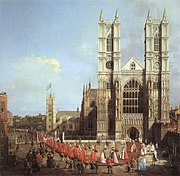
| Part of a series on the |
| History of the Church of England |
|---|
 |
This article traces the historical development of the dioceses and cathedrals of the Church of England. It is customary in England to name each diocese after the city where its cathedral is located. Occasionally, when the bishop's seat has been moved from one city to another, the diocese may retain both names, for example Bath and Wells. More recently, where a cathedral is in a small or little-known town or city, the diocesan name has been changed to include the name of a nearby larger city: thus the cathedral in Southwell now serves the diocese of Southwell and Nottingham, and Ripon Cathedral was in Ripon and Leeds from 1999 until 2014. Cathedrals, like other churches, are dedicated to a particular saint or holy object, or Christ himself, but are commonly referred to by the name of the city where they stand. A cathedral is, simply, the church where the bishop has his chair or "cathedra".
The forty-two dioceses of the Church of England are administrative territorial units each governed by a bishop. Forty-one dioceses cover England, the Isle of Man, the Channel Islands, the Isles of Scilly, and a small part of Wales. One diocese, the Diocese in Europe, is also a part of the Church of England (rather than a separate Anglican church such as the Church in Wales), and covers the whole of mainland Europe, the countries of Morocco and Turkey, and the territory of the former Soviet Union.
The structure of the dioceses within the Church of England was initially inherited from the Catholic Church as part of the English Reformation. During the Reformation, a number of new dioceses were founded. No new English or Welsh dioceses were then created until the middle of the 19th century, when dioceses were founded mainly in response to the growing population, especially in the northern industrial cities.
From 1787, the Anglican church also erected 41 dioceses outside these isles (see § colonial dioceses); these were part of the Church of England until they were separated from the home Church in 1863. From 1801 until 1871, the dioceses of Ireland were also part of the United Church of England and Ireland. In 1920 (by the Welsh Church Act 1914), the Welsh dioceses were separated to form the Church in Wales.
The last dioceses were created in 1927. The 42 dioceses are divided between two Provinces: the Province of Canterbury (with 30 dioceses) and the Province of York (with 12 dioceses). The archbishops of Canterbury and York have pastoral oversight over the bishops within their province, along with certain other rights and responsibilities.
